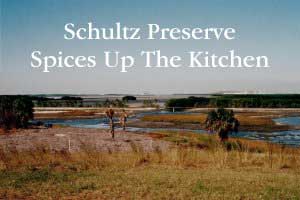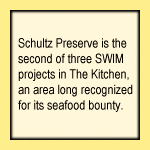
COVERING TAMPA BAY AND ITS WATERSHED |
Our subscribe page has moved! Please visit baysoundings.com/subscribe to submit your subscription request. |
||||||
Today, it‚s a showcase restoration effort, created through a partnership that encompasses nearly two dozen state and local agencies, corporations and volunteer organizations. „We built in as much complexity as we could,š says Brandt Henningsen, senior environmental scientist with the Southwest Florida Water Management District‚s Surface Water Improvement and Management (SWIM) program. „It mimics Mother Nature with mounds and dips and curves that encourage diverse wildlife.š
„Some nearby communities were discharging stormwater directly to the bay, but we‚re capturing it to improve water quality and lower salinity at the same time,š he notes. Five separate freshwater ponds are lined with marsh grasses to filter nutrients and other contaminants from stormwater before it overflows into channels that lead to the preserve‚s protected lagoon. Schultz Preserve is the second of three SWIM projects in The Kitchen, an area long recognized for its seafood bounty. Sixty acres of upland and wetland restoration were completed in 2002 at the Davis Tract and work will begin this year on the 24-acre Dug Creek project. A Community Effort While SWIM was instrumental in the design and funding of the Schultz Preserve, it has been a community-wide effort ever since the idea was conceived. It first came up at a meeting between Ann Paul and the Concerned Citizens of Gibsonton. Paul, then assistant manager of the Audubon Society‚s Florida Coastal Islands and Sanctuaries, was working on a grant from Cargill and Lewis Environmental Services to identify land near the Alafia River for preservation. Pete and Jeanie Johnson, longtime area residents and leaders of the citizens‚ group, immediately thought of Port Redwing. „Jeanie knew the name and phone number of the real estate agent trying to sell Port Redwing, and it didn‚t take long to sell the idea to the owner, the water management district, the county and the port,š said Paul, now sanctuaries manager. Economic constraints and environmental concerns had stymied development for the past 30 years so turning half the site into a preserve made sense to the owner. Additionally, the Tampa Port Authority had been eyeing the site but couldn‚t afford the entire 250 acres. „It didn‚t make sense to lose the deepwater port as an engine for economic development, but setting off the northern half as a preserve was a way to help minimize impact to a very sensitive area of Hillsborough Bay,š Paul said. Public Access Still A Question When the Hillsborough County Parks, Recreation and Conservation Department partnered with SWIM in 1995 to purchase the northern half of Port Redwing, the plan was to build a passive park with hiking and kayak trails as well as beach access. The southern section Ų one of the only undeveloped deepwater ports in the state Ų was a critical element in the port‚s expansion and economic development. Plans for public access to the Schultz Preserve changed on 9-11-2001 when port security became a top priority, and have still not been finalized. Originally, the port and the park would have shared an access road but that is no longer an option without security fencing. The parks department also must identify approximately $200,000 to develop recreational facilities, and a time frame for opening the Schultz preserve has not been determined. A cut above the rest:
|
|||||||
|
|||||||
|
© 2004 Bay Soundings
|
|||||||

 Just two years ago, the preserve was a flat, featureless peninsula covered in Brazilian pepper and practically devoid of wildlife. Jutting out from the southeastern shore of Hillsborough Bay, it was the result of dredge-and-fill activities in the 1960s that built high lands and deep channels in shallow bay bottom.
Just two years ago, the preserve was a flat, featureless peninsula covered in Brazilian pepper and practically devoid of wildlife. Jutting out from the southeastern shore of Hillsborough Bay, it was the result of dredge-and-fill activities in the 1960s that built high lands and deep channels in shallow bay bottom. Scientists seldom have the opportunity to restore bay bottom, sand bars and salterns, but the Schultz Preserve includes nearly 50 acres of estuarine habitat, highlighted by five sets of artificial reefs Henningsen calls the most complex ever constructed in Tampa Bay. The 120-acre site also encompasses 10 acres of freshwater wetlands, strategically located to capture stormwater from neighboring properties as well as the preserve itself.
Scientists seldom have the opportunity to restore bay bottom, sand bars and salterns, but the Schultz Preserve includes nearly 50 acres of estuarine habitat, highlighted by five sets of artificial reefs Henningsen calls the most complex ever constructed in Tampa Bay. The 120-acre site also encompasses 10 acres of freshwater wetlands, strategically located to capture stormwater from neighboring properties as well as the preserve itself.